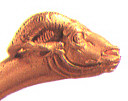
site map
Golden Fleece > Joppa
craftsman's art and music's measure
for thy pleasure all combine.
Joppa
meaning beauty
Ancient sea port
Joppa is the name in the English Bible for the ancient sea port of Jaffa (derived from ancient Hebrew word yafah, meaning "beautiful"). The cedars of Lebanon for the Second Temple of Jerusalem (Ezra 3:7) were landed here and then taken East to Jerusalem as had been the cedar for Solomon's Temple (2 Chronicles 2:16)
Jamnia
The Greek name for town south of Jaffa. After the fall of Jerusalem (A.D. 70), it became one of the most populous cities. (Hebrew Jabneel Meaning: built by God)
During the seige of Jerusalem, a Rabbi ordered a coffin and had himself carried in it to the Roman army beyond the walls - as a symbol of the subjugation of his people. Titus agreed to his request to be allowed to establish an academy at Jamnia. For the next fifty years distinguished scholars from around the world gathered at Jamnia to debate the many differing versions of the ancient sacred texts. The result was an agreed Hebrew text, that would be carefully copied by scribes for over a thousand years until printed copies were produced in 1488. At the time this monumental scholarly work was compared to the rebuilding of Solomon's Temple.
These printed Hebrew scriptures were translated into German by Martin Luther and also used by the scholars, who produced the English Bible for King James in 1611. The Company of Stationers paid the costs associated with this revision of the English Bible. About ninety percent of Tyndale's translation was retained to comply with the direction to retain familiar biblical names and popular passages. Among the new words introduced were allegory and victim from the Douai Bible, which had been translated into English from Latin.
Tel Aviv
Tel Aviv (Spring Hill) was founded in 1909 on the outskirts of the ancient port city of Jaffa (to the north). The growth of Tel Aviv soon outpaced Jaffa, which was largely Arab at the time.
The concept for a new garden city, to be called Tel Aviv, was developed on the sand dunes outside Jaffa in 1909. British urban planner Patrick Geddes, who had previously worked on town-planning in New Delhi, was commissioned by Tel Aviv's first mayor, Meir Dizengoff, to draw up a master plan for the new city. Geddes worked from 1925 to 1927 on the plan, which was accepted in full by the council. The view of British Mandatory authorities seemed to have been supportive. Patrick Geddes laid out the streets and decided on block size and utilisation. But he did not prescribe an architectural style for the buildings in the new city. By 1933, many Jewish architects of the Bauhaus school in Germany, which was closed down on the orders of the Nazis, fled to the British Mandate of Palestine. The residential and public buildings were designed by these Bauhaus-trained architects, who took advantage of the absence of established architectural conventions to put the Bauhaus principles into practice. The Bauhaus style, with its emphasis on functionality and inexpensive building materials, was perceived as ideal in Tel Aviv. In 2004, United Nations Educational, Scientific and Cultural Organization (UNESCO) named Tel Aviv a World Heritage Site for its treasure of Bauhaus architecture. Tel Aviv's White City is home to more buildings in the Bauhaus - or Modern Movement - style than anywhere in the world.
The romantic name Tel Aviv ("Hill of Spring") was chosen for the new community in 1910 partly because of its associations with rebirth and revitalization, and partly because it recalled the vision of Ezekiel. In the biblical Tel Aviv of Babylon, the exiled prophet saw the vision of animated dry bones, which drew him back to Israel.
Copyright © 2001-2010 The Fleece. All rights reserved.